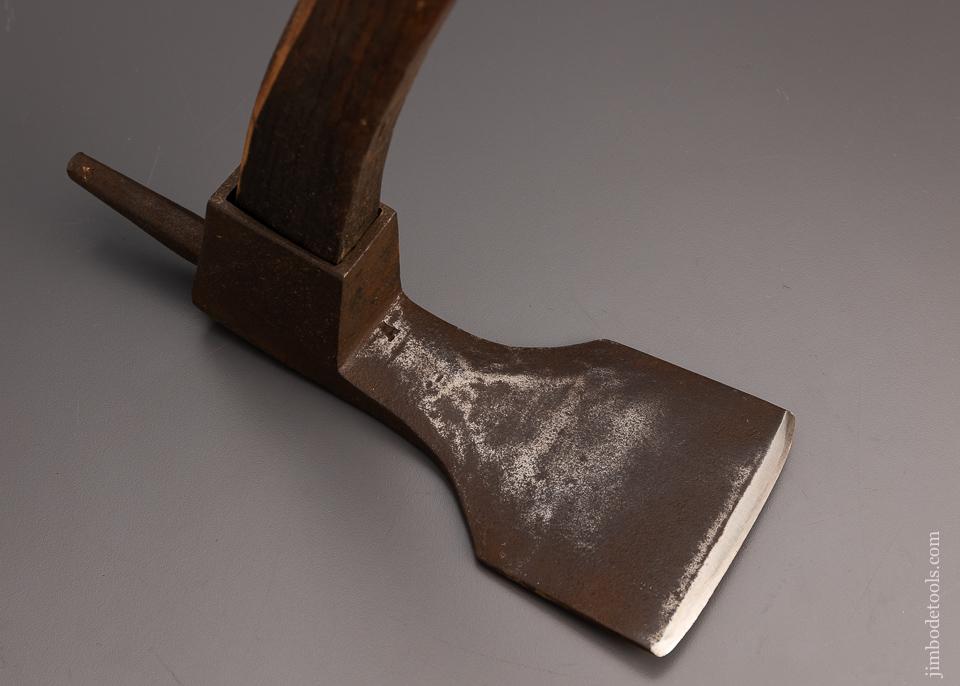

Most of the work that used to be done with them has been replaced by powered hand planers. An adze is a nice thing to have if you are a tool collecting wonk, but you probably won't get a lot of use out of one. Truth be told, I've yet to hang it as I haven't had need to use it since. You could easily make your own if you had a nice piece of the proper wood with the grain running correctly, but I found one in a WoodCraft store and snagged it for a very reasonable price. I got just the head, of course, and bought a handle. I forget if I got my Collins lipped adze off of eBay or somebody tipped me off to it, but it was "new old stock" and still in the original packaging, never used.


Collins is still in business, (I think it's the same Collins company.) They make a nifty aftermarket rounded shoe for sabre saws that permits cutting rolling bevels. (Of the 23 known woodworking puns, a fair share involve the adze.Since those old posts eight years ago we've lost Dave Fleming (sigh.) and I've acquired a Collins lipped adze. You'll find shipwrights using adzes with three-quarter length handles at close quarters.Ī final technical term for adzing: When a timber has been worked over 50 percent of its surface, it is known as half-adzed. Shipwrights, unlike carpenters, very often work in an arc in front of them. Without the lips, trenching would be rough edged and much harder, as the splinters would be constantly entrapping the adze. The shipwright's lipped adze will do all that a carpenter's adze will do, and excels at cutting a trench across the grain of a timber. This mass also makes them tiring to use with rapid, precise blows-but that's not what they're made for. Intended for work on railroad ties, their inertial mass can pop out big chips of wood. These railroad plate-layers adzes have a thick, heavy poll (the head opposite the edge). There are also adzes that are intended to split and chop as well as shear a surface. If the handle were wedged in place like that of an axe, it would always be in the way as you tried to grind the bevel.Ĭarpenter's adzes are rather light tools, worked at high speed removing thin chips that bend up and allow the edge to cut smoothly without splitting. Since the adze has to go on the grindstone now and then, the handle has to be removable. To keep its razor edge, an adze is usually hardened to the same degree as a chisel-too hard for a file. As one writer noted, "It is fearful to contemplate an error of judgment or an unsteady blow." The wedge action is stymied because the worker's shoe holds down the wood until the edge slices it off. For extra smooth work, therefore, some workers set their foot on the surface and swing the blade to cut beneath it. There is always a chance that unwanted wedging action would cause the wood to splinter ahead of the edge. You can work with the grain, across it, or diagonally. The edge slices off thin chips, more like broad shavings. In experienced hands, it is dead accurate and leaves behind a smooth, lightly scalloped surface. You adjust the depth of cut with your body position, while, down on the business end, the flat face hammers ever so slightly against the previously worked surface and guides the edge into the unworked wood. While one hand powers the tool, your other hand anchors the end of the handle against your body. This flat face curves gently back from the edge, matching the swing of the tool. The common adze is a single-bevel tool worked with the flat face against the wood. In 1678, Joseph Moxon described the adze being used "to take thin Chips off Timber or Boards, and to take off those Irregularities that the Ax by reason of its Form cannot well come at and that a Plane (though rank set) will not make riddance enough with." Tusser mentions the countryman using an adze to "make trough for thy hogs." The adze can hollow a hog trough, but the adze is also a faster-working alternative to the plane.


 0 kommentar(er)
0 kommentar(er)
